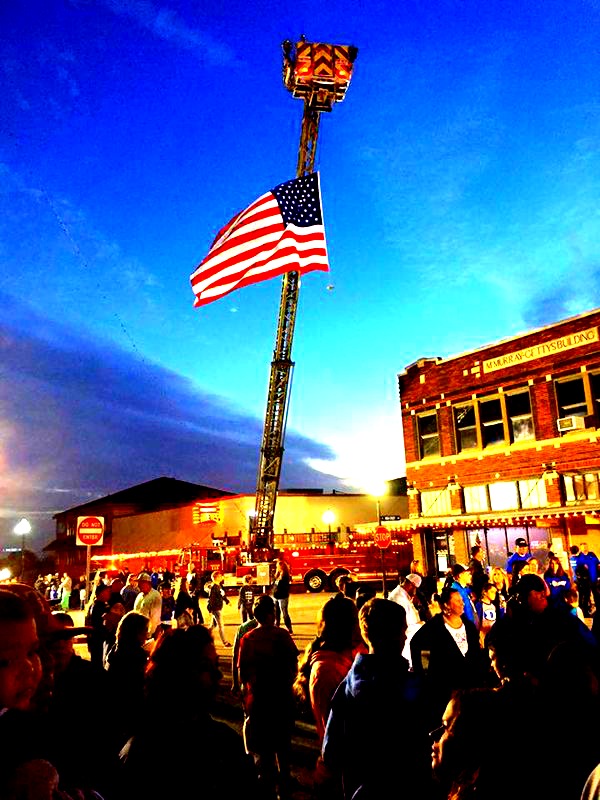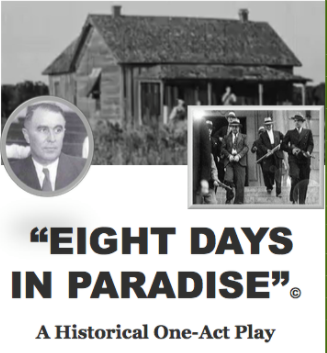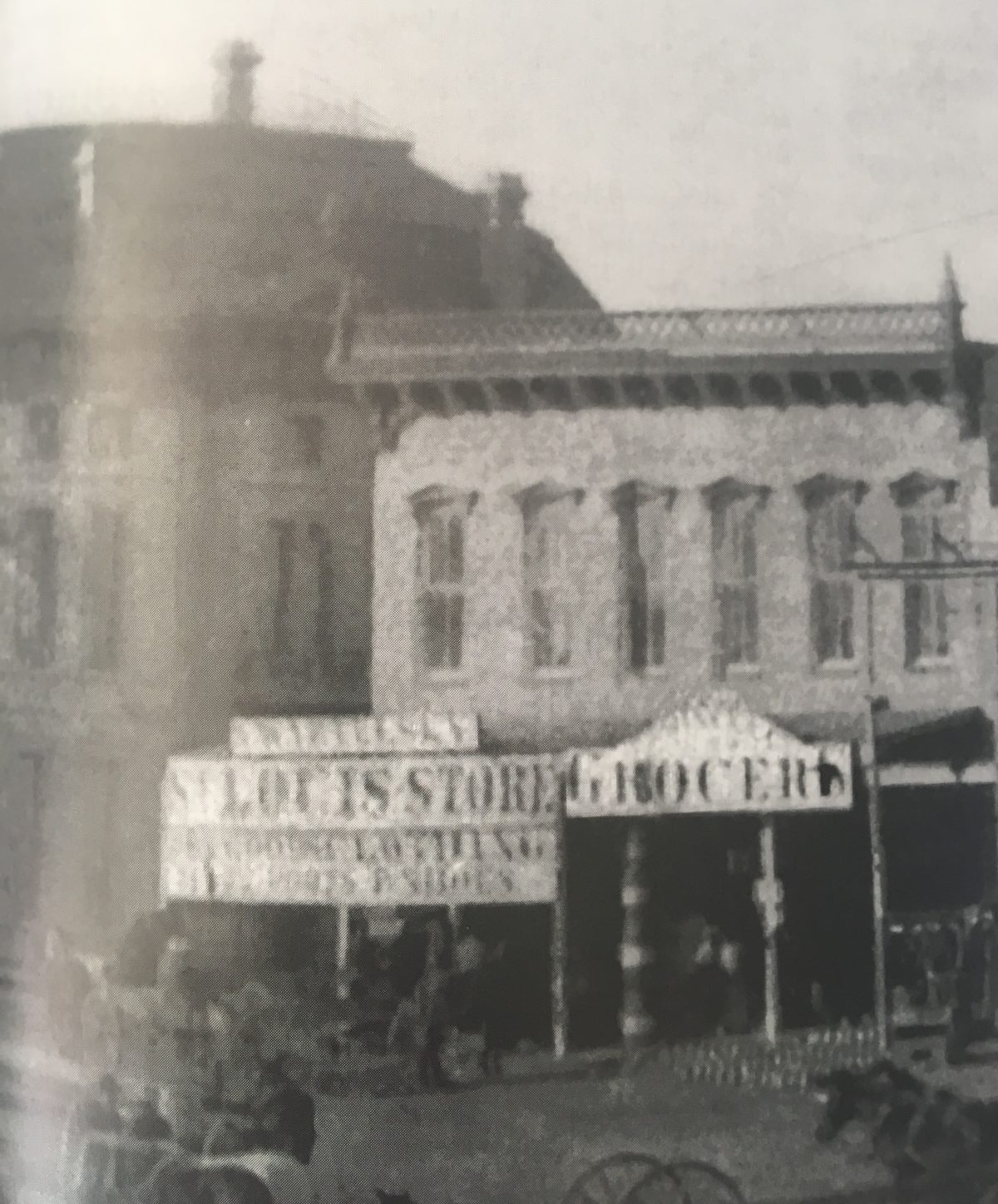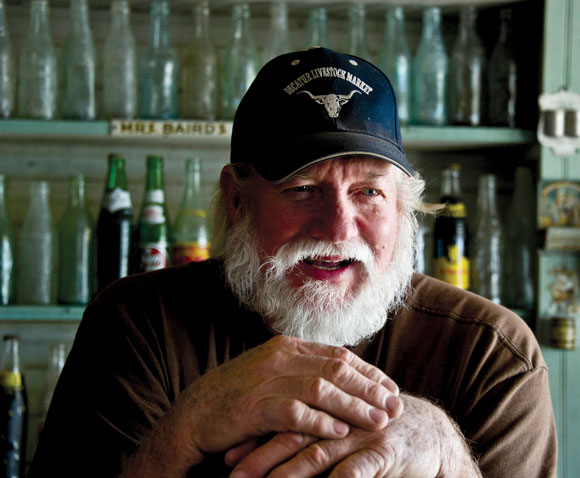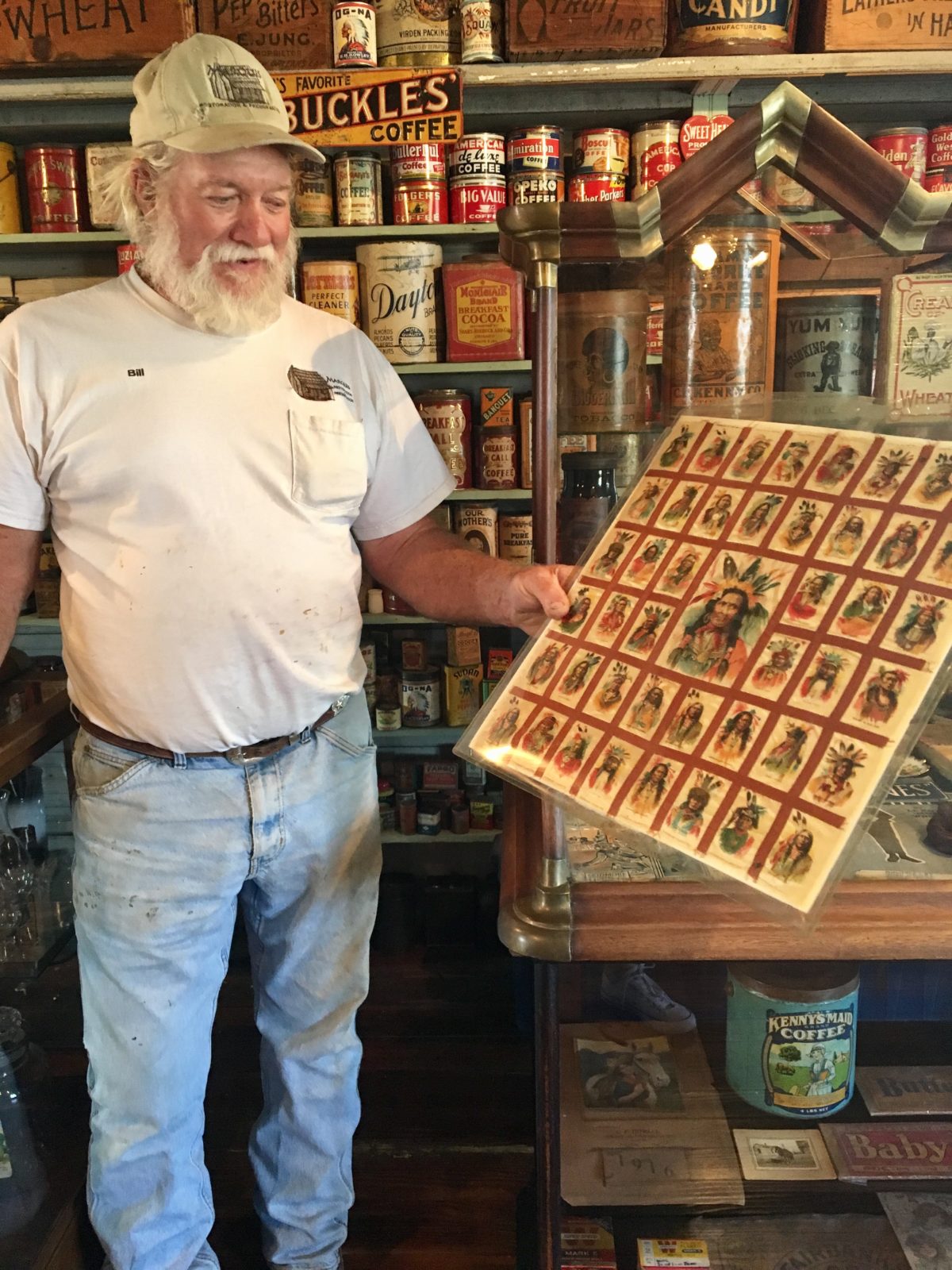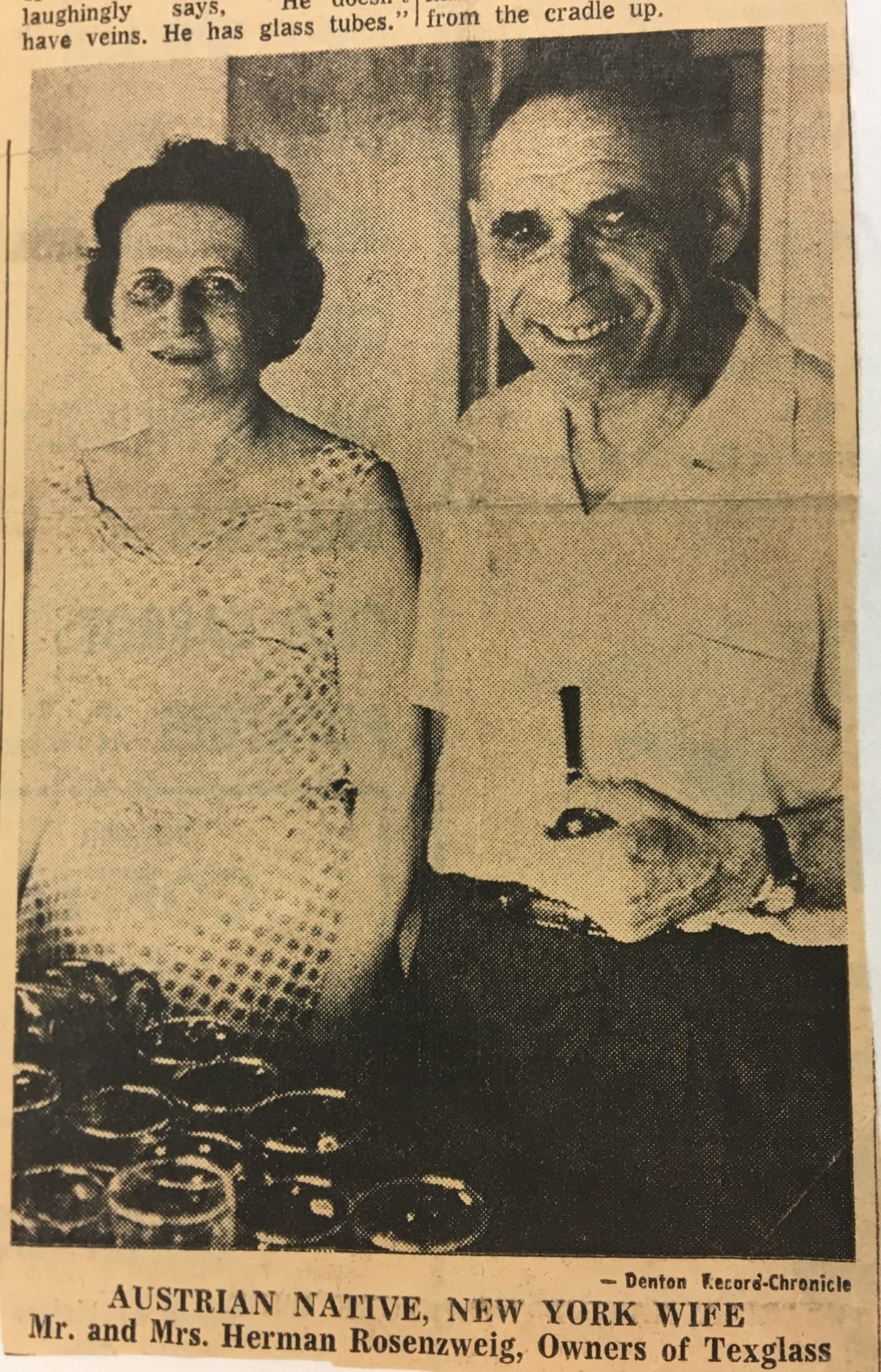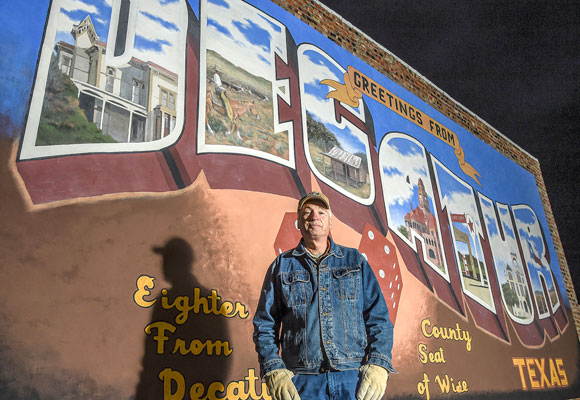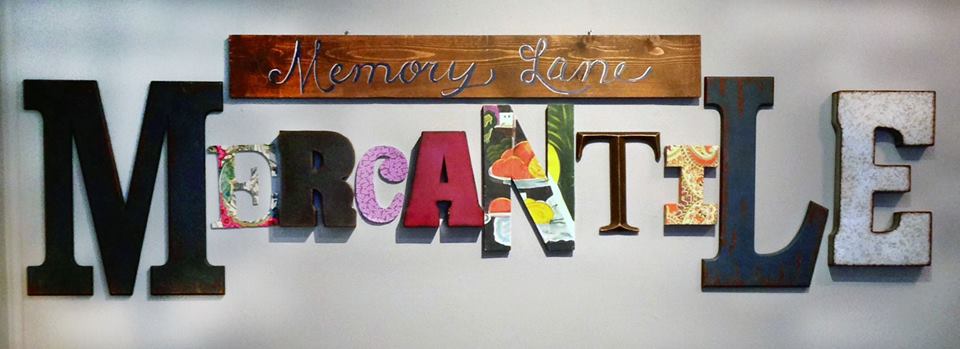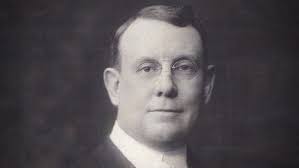Women’s Boutique with Cowgirl Flair featuring Consuela bags and merchandise, jewelry, gifts and home decor.
Category: Uncategorized
Texas Tourist Camp Complex
The Texas Tourist Camp and Petrified Wood Gas Station stand like relics from that by-gone era on the east side of Decatur, an old Chisholm trail town which used to be the site of the Decatur Baptist College (now, it’s the Dallas Baptist University). The complex consisted of a gas station, five cabins, and a café. Today, only the café serves its original purpose.
It actually began as a camp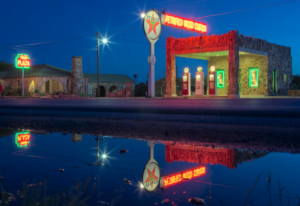 ground on the edge of town. In 1927, owner E.F. Boydston, realized that money could be made as people began travelling for leisure, so he added a gas station, and in 1929 opened the Texas Lunchroom for hungry road trippers. In the early 30’s, Boydston built cabins with garages to offer more comfortable settings. To REALLY spruce things up, his brother Nolan put petrified wood (quarried from around the area) on the exteriors in 1935. The tourist court became an attraction in its own right, and remained popular throughout the 30’s, 40’s, and 50’s for locals, travelers and college kids.
ground on the edge of town. In 1927, owner E.F. Boydston, realized that money could be made as people began travelling for leisure, so he added a gas station, and in 1929 opened the Texas Lunchroom for hungry road trippers. In the early 30’s, Boydston built cabins with garages to offer more comfortable settings. To REALLY spruce things up, his brother Nolan put petrified wood (quarried from around the area) on the exteriors in 1935. The tourist court became an attraction in its own right, and remained popular throughout the 30’s, 40’s, and 50’s for locals, travelers and college kids.
As typical North Texas history goes, Bonnie and Clyde supposedly stayed in one of the cabins for a few nights. Since the Texas Tourist Camp didn’t make guests sign a register, and the couple used the back roads into Dallas constantly, the claim may not be too far fetched. 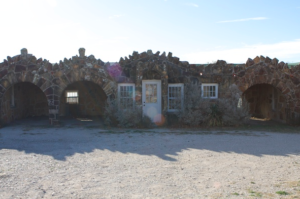
Sadly, the Texas Tourist Camp went the way of juke boxes and poodle skirts. As Interstates began bypassing whole towns, it slowly began its demise. First, the Texas Lunchroom closed in 1964… about ten years later, the cabins shut their doors for good. The gas station remained open until 1989.
In 1992, some enterprising souls bought and remodeled the Texas Lunchroom, renamed it the Texas Café, and now cook up hamburgers, chili, and apple pie. The Boydston living quarters are insurance offices, and the gas station serves as an office for the remaining family.
A Town Square
A town square is the heart of the community, an intimate grouping of old-fashioned buildings that still have a very relevant purpose. It is a place that is not only an architectural gem, but a hub that welcomes long-time residents and newcomers alike.
The square creates an intimate area to do business, shop and eat. Coming to the square is an experience. Sure you may not find a parking space right out front, and you certainly cannot drive through anywhere, but that is the purpose. We still need to meet up with friends, connect with neighbors, slow down and stroll. When was the last time you visited Decatur Town Square?
It has been a banner year! D Magazine recognized our square in its November issue “10 Great Day Trips to Small Towns around Dallas”. Many are discovering it! The square will continue to evolve as it attracts unique business that adds to the experience that is Decatur, and many people are working hard to make sure that it not only stands out but thrives! Come on down and see what you have been missing!
Eight Days in Paradise
During the throes of the Great Depression, desperate times led to desperate, reckless activities. Texas became a hotbed for criminals. The most notorious being Bonnie and Clyde, but a bank robber was making quite a name for himself thanks to his ambitious wife. George and Kathryn Kelly were residing on Mulkey Street in Fort Worth at this time. George was known by his big-time nickname of “Machine Gun” Kelly. Kathryn, hoping to promote her husband’s status in the criminal world, encouraged him to plot a kidnapping.
On the evening of July 22, 1933, an innocent game of bridge among friends was suddenly interrupted. “Machine Gun” and his long time partner, Albert Bates, held up oil magnate Charles F. Urshel and friend Walter Jarrett with his famous machine gun. While they were only interested in Urshel, they ended up leaving with both men as their helpless wives looked on.
Charles F. Urshel was first married to Flored Slick, sister of Thomas Baker Slick, Sr., who discovered the vast Cushing Oil Field in Oklahoma earning him the title “King of the Wildcatters.” Slick died in 1930 and after Flored’s death Urshel married Slick’s widow, Berenice. Their combined fortunes made them one of the wealthiest couples in Oklahoma City. Urshel, in Kathryn Kelly’s mind, was their ticket to the big time.
Walter Jarrett was soon released, but Charles Urshel was taken to a remote farmhouse in Paradise, Texas where he was held blindfolded for nine days. He was forced to write his own ransom note for $200,000. His kidnappers had not counted on Urshel’s determination and keen memory. He memorized with vivid detail every aspect of the ordeal. He was able to recount the weather, patterns of plane flight, times, directions and voices even though he was blindfolded. He also made sure to leave fingerprints on every surface he could reach.
After the ransom was paid by a close business associate, Urshel was freed on a rainy night in Norman, Oklahoma with only cab fare in his pocket.
J. Edgar Hoover, hoping to improve the reputation of his agency, took a particular interest in the case. It would be the first time to put the new Lindbergh Laws into action. Due to pressure from Hoover and the incredible amount of detail Urshel was able to provide, FBI agents found the hideout in short order. The farm, being used as a safe house for bank robbers, was owned by Kelly’s in-laws, Robert “Boss” Shannon and wife, Ora. All told, the case would lead to twenty-one convictions including a life sentence for “Machine Gun” Kelly. When finally captured unarmed, he famously yelled, “Don’t shoot G-Men” thus coining a new nickname for FBI agents still in use today. The trial took place in a packed Federal courtroom and would be one of the first ever filmed. Hoping to put the ordeal behind them, the Urshels moved to San Antonio for the remainder of their lives. Paradise Texas would forever be associated with one of the most notorious bank robbers of all time.
112 West Walnut
Open the door to 112 W Walnut and find yourself enveloped by the enticing aroma of vanilla from Sweetwater Café & Bakery, but this building is much more than sugar and spice. No building on the Decatur Town Square has had a more diverse history. Prior to 1880 Absalom Bishop, “father of Decatur,” built a home on the site for his and his son-in-law, Edward Blythe’s families. The home was large and often protected early settlers from moonlight Comanche raids. 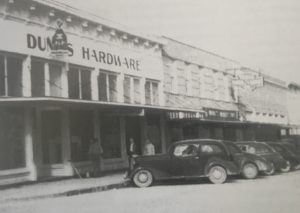 The family ran a mercantile store called Bishop & Blythe from 1859-1879 all while being instrumental in organizing the territory into a community, changing the name from Taylorsville to Decatur and making it the County seat. After the store went bankrupt in 1879, J.J. Lang purchased the lot in 1881 and erected a new stone structure. The first floor became a grocery store called the St Louis Store, and professional offices including the dental office of Dr. D.H. Payne were upstairs. Perhaps the most unusual occupant was announced in 1893 when the Decatur Ensor Institute for the treatment of liquor, morphine, cocaine, and tobacco and cigarette habits opened for business. The building burned in December of 1893. Lang’s daughter re-built and a billiards hall touted as “a pleasure resort for gentlemen” occupied the space in 1904. Through the early part of the 1900’s as the community grew and evolved the building’s occupants changed to meet new needs serving as a repair shop, millinery store, variety store and a dry goods store.
The family ran a mercantile store called Bishop & Blythe from 1859-1879 all while being instrumental in organizing the territory into a community, changing the name from Taylorsville to Decatur and making it the County seat. After the store went bankrupt in 1879, J.J. Lang purchased the lot in 1881 and erected a new stone structure. The first floor became a grocery store called the St Louis Store, and professional offices including the dental office of Dr. D.H. Payne were upstairs. Perhaps the most unusual occupant was announced in 1893 when the Decatur Ensor Institute for the treatment of liquor, morphine, cocaine, and tobacco and cigarette habits opened for business. The building burned in December of 1893. Lang’s daughter re-built and a billiards hall touted as “a pleasure resort for gentlemen” occupied the space in 1904. Through the early part of the 1900’s as the community grew and evolved the building’s occupants changed to meet new needs serving as a repair shop, millinery store, variety store and a dry goods store. 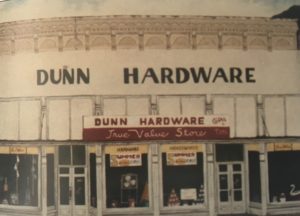 In 1933, at the height of the Depression, Dunn’s Hardware opened. Thomas J. Dunn and son, John Thomas Dunn, first leased their space later purchasing the building in 1940 from the Bellah family. World War II was a struggle for the business as Dunn’s son was in the Navy and all his salesmen left town. Dunn persevered, modernized the building, and added a new store front in the 1960’s. Despite all the hardships, Dunn’s Hardware had a remarkable 57 year run in this location. The hardware store closed in 1991 and then in 1993 the metal slip cover was removed to return the building to its current historical status. Carol Ann Carson purchased the property in 2004. Next time you are waiting for your pancakes, let your mind wander and try to imagine citizens from the early days of Decatur strolling through the doors of this historical building going about their daily business and picture a square so full of people you couldn’t stir them with a stick.
In 1933, at the height of the Depression, Dunn’s Hardware opened. Thomas J. Dunn and son, John Thomas Dunn, first leased their space later purchasing the building in 1940 from the Bellah family. World War II was a struggle for the business as Dunn’s son was in the Navy and all his salesmen left town. Dunn persevered, modernized the building, and added a new store front in the 1960’s. Despite all the hardships, Dunn’s Hardware had a remarkable 57 year run in this location. The hardware store closed in 1991 and then in 1993 the metal slip cover was removed to return the building to its current historical status. Carol Ann Carson purchased the property in 2004. Next time you are waiting for your pancakes, let your mind wander and try to imagine citizens from the early days of Decatur strolling through the doors of this historical building going about their daily business and picture a square so full of people you couldn’t stir them with a stick.
Opera House
CATES OPERA HOUSE ON DECATUR TOWN SQUARE
1893-1911
The late 19th century ushered in the Progressive Era in Texas. The state was on the verge of an oil boom and new citizens, full of optimism, were flocking to new opportunities. Cities were growing ten times faster than the countryside. Fort Worth was a shipping point for the cattle drive making it one of the top five cities in Texas and causing tremendous growth for surrounding areas. As the towns grew, culture began to mature due to a desire of the newly wealthy to support and promote artists, musicians, and writers. Opera houses began to spring up in towns all over Texas to satisfy the need for social outings. Born out of a desire to foster daughter Ada’s interests in classical music and his love of the theater, Charles D. Cates opened the Cates Opera House on East Main just off the square in what was originally a dry goods store. On the evening of December 4, 1893, women dressed in brocades, silks and velvets along with gentlemen adorned in top hats drew up to the two-story stone building in horse-drawn carriages in anticipation of “good, clean fun.” Coal oil lamps glittered, and a full balcony known as a “roost” seated the overflowing crowd. A new and amazing special effect, colored lighting, was produced by burning metallic powders in a pan hidden on the stage. A hand painted drop curtain with a European lake scene hid surprises to come. The performance of the night was the famous production of “Skipped by the Light of the Moon.” The Wise County Messenger described the theater going experience as “worthy and innocent amusement that keeps people in a healthy state of mind, content with their lot.”
Thanks to improved transportation across the U.S. traveling shows became a big industry. A touring company would perform for a week presenting variety shows in Dallas and Fort Worth. Decatur, because of its proximity to the two bustling cities, would be included on the tour giving it the benefit of headlining performances. Being in the country did not deter Decaturites from enjoying a fun night out. The Cates Opera House presented its audiences with plays such as “The Count of Monte Cristo,” “Pygmalion & Galatea” and “Lady Macbeth. “ Plays were especially well attended during Reunion. While the goal of Mr. Cates was to present culture to his community, the Opera House was used for many events other than theater. Young people dances, as well as balls to celebrate local marriages, were held on the premises. Occasionally churches like the Presbyterian Church would hold monthly services at the location. Benefits were organized to support local lodges. In 1902, on the evening of George Washington’s birthday, the Owl Club presented a play honoring the life of the great American hero. Participants were dressed in colonial garb, and ticket holders were treated to a booth selling punch and candy and delighted by two beautiful gypsies telling fortunes. Fifty dollars was raised to purchase books for the club’s library. There were boxing contests and vivid mock bull fights. For the price of a few cents, theatergoers could be transported to another country or time. One particular performance of the “Execution of Marie Antoinette” featured a guillotine, Marie’s headless body and oozing blood and gore. The Cates Opera House took great pleasure in featuring local talent, and the town loved to show off! In 1894 the ladies of the Episcopal Church held a performance to warm applause. The town turned out in droves in 1884 to witness the first appearance of the Decatur Amateur Comedy Company for the purpose of purchasing a hook and ladder truck. One of the largest Decatur audiences ever was for “The Pioneers” a three-act play depicting life on the frontier following the Civil War. Twenty local ladies and gentlemen including Cliff Cates, CV Terrell, Floyd M. Kenny, William Renshaw, Will Terrell and Mary Cates played parts, and the proceeds went toward the debt incurred from publishing the Old Settlers History in Wise County. Eighty dollars was raised. It was a big hit! In 1900 a band concert under the direction of Professor Koch showed off the talents of BB Sellars on the coronet, Mrs. CH Smith on the violin and singers Ada Cates and Edna Earhart. Many felt the community should have supported the efforts of their talented inhabitants more. Lecture series, which were popular inspirational talks in the late 1800’s, were presented to educate the audience. The Opera House hosted the Gaylord Illustrated Lectures in 1888 and “America’s Uncrowned Queen” in 1895 was billed as the finest lectures ever given in Decatur. Vaudeville shows including hypnotists, Tyrolean yodelers, and novelty whistlers were hugely popular. In 1905 the Lyceum Stock Company from New York City who employed the most prominent actors and produced the most notable plays of the time brought with it a full complement of actors, sets, musicians, crew and publicists to present “A Hoosier Romance.” In 1906 the season opener enjoyed a sizeable crowd for “The Cowboy’s Girls.” Other memorable shows from this season included “Dora Thorne” hailed as the best play in Texas that season and “Them Dreadful Twins” presented by Richard & Pringles Georgia Minstrels which was an African American group who performed plantation songs and skits and helped launch the careers of several Jazz and Blues performers. In 1907 “The Banker’s Child” was guaranteed a good show or your money back! In 1908 Downs the Magician, a self-taught illusionist hailed as the youngest ever on record presented memorable sleight of hand and coin tricks. He is still admired among today’s magicians.
Despite a major renovation in 1908 including all new scenery painted by famous scenic artist Frank M. White in hopes of increasing ticket sales, the Cates Opera House would not survive. One of the last shows in 1911 “Dan Cupid” featured an entire chorus of beautiful girls in full evening dress. In 1913 the building became the ice cream parlor for the San La Roy restaurant. In August of 1913, the building was dismantled, and Lillard Milling Company purchased the lot of rock. The city hoped to make the plot of land a city park.
There is a little piece of paradise in Stony, Texas where history comes alive.
Bill Marquis has always loved anything old…old buildings, old objects, old people. He loves telling stories and anything that tells a story. He makes his home on land that was part of the original legendary 6666 Ranch. He makes his living restoring and creating. He humbly states that it all came out of “common sense.” He appreciates hard work and acknowledges the old way of doing things is just better and well worth the effort.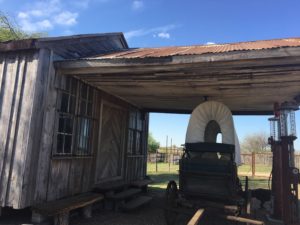
This man whose background is as impressive as his collections and his profession seems larger than life. He is the son of a man who was once picked by General Patton as one of his top five marksmen sent to hunt down Hitler. His father never found Hitler, but he did find his pistol and carried it for the rest of the war.
Visitors to this amazing property will first notice the unusual fence made out of antique tools and implements which leads to even more unique arched gates designed by the Marquis. The land sits on the Balcones fault which runs all the way to Austin, Texas. Marquis extracted Ammonites which are fossils of an extinct group of marine mollusk animals that lived anywhere from 240 to 65 million years ago from his land. The fault makes the soil rich in these fossils which are ribbed, spiral shell forms. Marquis designed and laid patterns in the gates, some resembling flowers, even working with petrified wood and gastroliths (grit swallowed by dinosaurs to help with the digestive process creating smooth, round stones). His wife, June, laid the brick for the gates. She used pavers from Thurber, Texas that were originally from the Fort Worth Stockyard. A man purchased the bricks to build a home, but every time it rained the smell of many years of cattle manure trod into the pavers assaulted the senses. It seems fitting that they found a home here.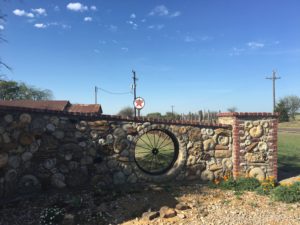
Among flourishing gardens and a meticulously groomed landscape is a giant, spherical rock. Every garden needs a meteorite, right? There is quite a story attached to this one. Legend has it that in 1886 the meteorite was glowing up in the mountains near the little town of San Carlos, Mexico. It was removed and placed in the center of the city with benches around it. People would sit in front the meteorite for healing. Marquis would regularly take hunting groups to the Big Bend area of Texas which is very near the little town. One year he was guiding a group of five couples, and they visited San Carlos. It had been a challenging year of drought, and the 104-year-old patriarch of the town made it known that he would be willing to sell the meteorite. Leaning on a cane, the old man agreed to deliver the meteorite to Texas for $400. Marquis gave him a $200 deposit and set a date to meet him never really expecting the old man to show up. Low and behold on the date arranged six Mexicans in an old truck with poles holding the rock appeared. They dumped the giant stone and drove off. People came from all over to watch the spectacle. Marquis had arranged a dual tandem trailer with a diesel truck for transport, but ten men could not get the rock on the trailer. It took two years to find someone with a semi that was willing to pick up the meteorite. The driver informed Marquis that the rock weighed over 80,000 pounds requiring three backhoes to remove it from the truck. The chunk of debris seamlessly blends into the beautiful landscaping like it was always meant to be there.
Historical buildings also dot the property. Marquis restored a 16×16 cabin built in 1836 where Burk Burnett was born. The Burnetts were forced to relocate to this area after the Jayhawker War in 1859. In front of this cabin, an original Bois D’Arc post from the 6666 Ranch is worked into the split rail fence as well as some pieces of Bill’s famed barbed wire collection.
Stony Texas was a prominent place before the railroads. Located halfway between Decatur and Denton it was a perfect stopping place. Marquis began to realize there were just a few buildings left in Stony and each year another one was being destroyed. He gradually moved what remained of the town to his property to restore. His first project was the Stony Baptist Church built in the 1870’s which now houses his woodworking shop.
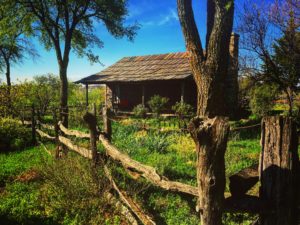 The last store in Stony constructed in 1912 was set for destruction. Marquis was determined to save it so he moved it in 2 days fearing someone would come along and demolish it. The ceiling had completely fallen. He restored it to reveal an exact replication of a general store at the turn of the century complete with a hornet’s nest for good luck. The store had originally housed the post office, a barber chair, pay phone and meat market. The original meat counter survives. The barber chair that is now on display was the chair that Clyde Barrow sat in every week while in prison to have his hair cut. Original shelves are home to an astounding array of vintage grocery tin and wooden boxes. His most valuable tin, he is told, is an Edward G Robinson pipe blend tin because it was produced without his permission.
The last store in Stony constructed in 1912 was set for destruction. Marquis was determined to save it so he moved it in 2 days fearing someone would come along and demolish it. The ceiling had completely fallen. He restored it to reveal an exact replication of a general store at the turn of the century complete with a hornet’s nest for good luck. The store had originally housed the post office, a barber chair, pay phone and meat market. The original meat counter survives. The barber chair that is now on display was the chair that Clyde Barrow sat in every week while in prison to have his hair cut. Original shelves are home to an astounding array of vintage grocery tin and wooden boxes. His most valuable tin, he is told, is an Edward G Robinson pipe blend tin because it was produced without his permission.
A few years ago, American Pickers of The History Channel fame heard of Marquis’ many collections and came for a visit. The hosts were fascinated with his General Store. Bill did not sell them anything, but he was happy to share his historical information with Frank and Mike.
Sadly our time with Bill flew by. He has many more stories to tell, and I could listen to him for ages. Many thanks to Bill Marquis and his lovely wife, June, for sharing their little piece of paradise with us.
Preserving the Craftsmanship of the Past
There is no way even to begin to categorize Bill Marquis –except extraordinary. Listening to him talk is like learning from a Master. 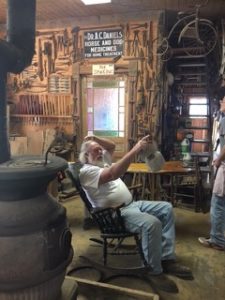 He is a self-taught restorer of historical cabins all around Texas. When asked how he learned to restore things he merely answers “common sense.” Bill has a great appreciation for anything old. He is an avid collector happily showing accumulations of branding irons, old doors, and vintage tins. His barbed wire collection numbering 11,000 put him in the Cowboy Hall of Fame. He is a historian who knows boundless information about Texas history and geography. He is a beekeeper using hollow logs for hives like the old people from Greenwood (where he grew up).
He is a self-taught restorer of historical cabins all around Texas. When asked how he learned to restore things he merely answers “common sense.” Bill has a great appreciation for anything old. He is an avid collector happily showing accumulations of branding irons, old doors, and vintage tins. His barbed wire collection numbering 11,000 put him in the Cowboy Hall of Fame. He is a historian who knows boundless information about Texas history and geography. He is a beekeeper using hollow logs for hives like the old people from Greenwood (where he grew up).  The bees produce a lot more honey this way. He makes beeswax candles that require dipping eighty times. He is a craftsman of exquisite furniture. He also designed and constructed the gates at the front of his property. Bill artfully displays his many collections on the walls of his home and workshop as well as his fences. His lovely wife, June, is an artist in her own right creating original Western watercolors and pencil etchings. She is also an amazing horticulturist. Bill has been a surfer as well as a game and bird watching guide for celebrities in the Big Bend area of Texas. A kind and patient man always ready with a story or joke, he never tires of repeating all the many facts that are part of his wealth of information.
The bees produce a lot more honey this way. He makes beeswax candles that require dipping eighty times. He is a craftsman of exquisite furniture. He also designed and constructed the gates at the front of his property. Bill artfully displays his many collections on the walls of his home and workshop as well as his fences. His lovely wife, June, is an artist in her own right creating original Western watercolors and pencil etchings. She is also an amazing horticulturist. Bill has been a surfer as well as a game and bird watching guide for celebrities in the Big Bend area of Texas. A kind and patient man always ready with a story or joke, he never tires of repeating all the many facts that are part of his wealth of information. 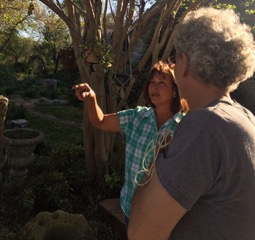 This man is incredibly hard working, and to see what he accomplishes in a day is mind boggling. Bill is doggedly determined once almost getting into a fistfight over trying to save the last store from Stony, Texas. After spending time with Bill, you realize there would never be enough time to learn all there is to him. It may seem like Bill Marquis is a tall tale hero, but he is, in fact, the real deal. Come to the Antique Western Show and Sale at the Decatur Civic Center on April 8th and 9th! Just the opportunity to meet Bill Marquis is reason enough to come!
This man is incredibly hard working, and to see what he accomplishes in a day is mind boggling. Bill is doggedly determined once almost getting into a fistfight over trying to save the last store from Stony, Texas. After spending time with Bill, you realize there would never be enough time to learn all there is to him. It may seem like Bill Marquis is a tall tale hero, but he is, in fact, the real deal. Come to the Antique Western Show and Sale at the Decatur Civic Center on April 8th and 9th! Just the opportunity to meet Bill Marquis is reason enough to come!
Texglass, Inc. (Decatur Glass)
“The rhythm and timing of the movements of glassmaking always have been and always will be fascinating. A good deal of the process is standard procedure with a certain amount of innovation” Herman Rosenzweig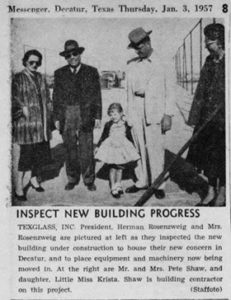
Every once in a while history comes alongside community. While communities are often associated with like-mindedness, when residents are unafraid to branch out, their locality becomes richer, more diverse, and open to new ideas. The group is willing to be touched by experiences of hope and perseverance from ordinary people fighting to keep their dreams alive.
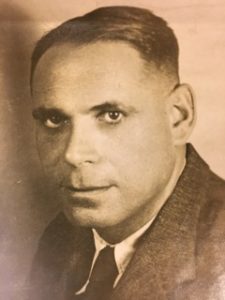 In the late 1950’s a glass maker in Athens, Texas was out of room for expansion and looking for a new location. He sent inquiries to towns within a hundred mile radius to see if any would be interested in a new industry. Decatur responded favorably and Texglass, Inc., owned by Herman and Bertha Rosenzweig, moved to town in 1957. The couple purchased three acres from CL Dodson and equipped with sand from Ardmore, lime from Chico, and soda ash from Houston set out to make handmade tableware. The glassware was crafted in their signature thumbprint style in an opulent array of colors such as amethyst, ruby, emerald, and amber. Here the small factory, when in full production, produced up to 600,000 glasses per year.
In the late 1950’s a glass maker in Athens, Texas was out of room for expansion and looking for a new location. He sent inquiries to towns within a hundred mile radius to see if any would be interested in a new industry. Decatur responded favorably and Texglass, Inc., owned by Herman and Bertha Rosenzweig, moved to town in 1957. The couple purchased three acres from CL Dodson and equipped with sand from Ardmore, lime from Chico, and soda ash from Houston set out to make handmade tableware. The glassware was crafted in their signature thumbprint style in an opulent array of colors such as amethyst, ruby, emerald, and amber. Here the small factory, when in full production, produced up to 600,000 glasses per year.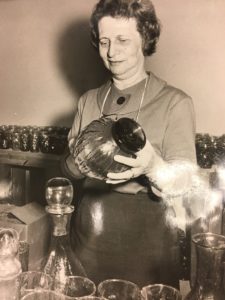
How did Texglass come to pass? What brought an Austrian Jew to Decatur, Texas? There is so much more to the story of the small factory that operated less than twenty years.
Herman Rosenzweig was born in Austria in 1901. The son of a hand-carved furniture maker, he had an affluent, Orthodox upbringing-playing piano and attending engineering college in Vienna. He started a glass factory in Vienna, but at the same time, Hitler was launching his attack on Eastern Europe. Herman, under threat, left just in time. He first went to Athens, Greece. There he was employed by a glass factory all the while working for the Underground helping Jews escape to Palestine.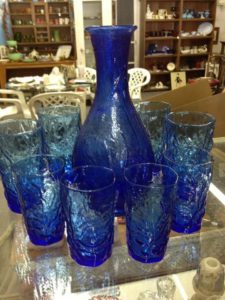 His supportive employer often covered for him keeping him out of jail on multiple occasions. Herman sent money for his mother and seventeen-year-old brother to go to Palestine. His mother was already interred in a concentration camp where she would later die. His brother made it as far as Northern Italy before being transported to a concentration camp and was not heard from for many years. He eventually ended up in the United States as a displaced person
His supportive employer often covered for him keeping him out of jail on multiple occasions. Herman sent money for his mother and seventeen-year-old brother to go to Palestine. His mother was already interred in a concentration camp where she would later die. His brother made it as far as Northern Italy before being transported to a concentration camp and was not heard from for many years. He eventually ended up in the United States as a displaced person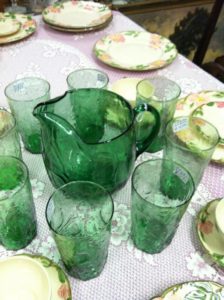
Needing to move on, Herman would next work as a chemical engineer in both Egypt and Palestine. By the early 1940’s Herman had made his way to New York. He was introduced to Bertha Heiden, a first-grade teacher also from Orthodox Austrian parents, in 1944. Herman kept seeing Bertha under the ruse that he needed help with his English. His wife would later say that both his reading and writing of English was impeccable. They married at her mother’s home on March 26, 1944. After they married, Herman worked in Canada for a while. In 1948 the couple went to Mexico City. Rosenzweig felt Mexican glass workers were superior as they saw the ancient tradition as an art.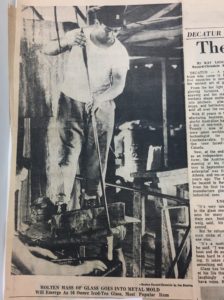
Herman had plans to open a new shop in San Antonio but was diverted to Athens, Texas. He would have made a lot more money going to work for a large company as a technologist, but he was determined to be his own boss. After realizing his Athens facility was no longer conducive to his work, Herman began to look for a new location. His biggest concern was if the community would support an influx of Mexican workers. Decatur was not only willing but enthusiastic to take on the new industry and all it entailed. Texglass, Inc. operated in a non-descript tin building just over the railroad tracks. There was never a sign because they ran out of money. The Rosenzweigs started with twelve employees mostly from the American consulate in Monterey, Mexico. They would eventually have twenty-five on their staff. Some of their workforce stayed many years and became very involved in the community. Relatives of former glassblowers and plant supervisors are still in the area. 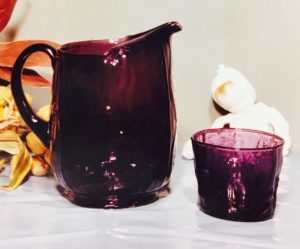 Ten salesmen were chosen to represent Texglass wares which included pitchers in different sizes, vases, decanters and several sizes of glasses all over the United States and Canada. Advertising was mostly word of mouth because the industry was so new in Texas. Salesmen would set up displays at the State Fair of Texas and take orders. Texglass sold to A. Harris (precursor to Sanger-Harris) and even sold to a Parisian department store.
Ten salesmen were chosen to represent Texglass wares which included pitchers in different sizes, vases, decanters and several sizes of glasses all over the United States and Canada. Advertising was mostly word of mouth because the industry was so new in Texas. Salesmen would set up displays at the State Fair of Texas and take orders. Texglass sold to A. Harris (precursor to Sanger-Harris) and even sold to a Parisian department store.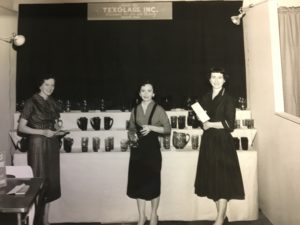
Herman Rosenzweig was short and stocky with a distinct accent. He had been a glassmaker all of his life working with the engineering and chemistry of glass. After coming to Decatur, he designed new iron molds and a burning machine that substantially reduced production time of the glass. Herman encouraged tours of the factory passing on his love of glassmaking. It pleased him to see children on their bicycles peering in windows to get a glimpse of the glass blowing process. He had a great helpmate in Bertha. After teaching school for 18 years, she now ran the office like a school room. He considered her invaluable. While Rosenzweig loved his employees, he had a distinct European mind-set that prevented him from socializing with his workers. Bertha, never having children of her own, showed great affection for the workers and was known as “Mom” by Texglass employees.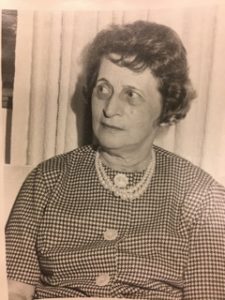
The glass factory was hard work and long hours. The Rosenzweigs believed every few cents that came in was worth it. The 2600 degree furnace was kept going twenty-four hours, and Herman would often be at the factory at midnight to monitor the tank. Emptying the tank to change the color of the glass was tedious and time-consuming. Only at Christmastime would they would turn off the tank, and all the workers would go home to Mexico for vacation.
Herman had plans to open another factory in Bowie for industrial purposes. This shop would have manufactured glass beads for highway paint. He also longed to make exquisite glass lamps similar to ones he would see in high-end advertisements. Sadly, these endeavors were not to be. He became ill and died in 1965.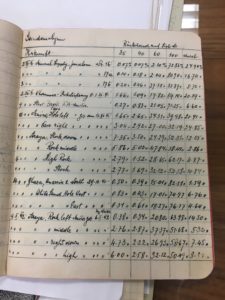
Bertha continued the business that they started together for another four years. She had great pride in her husband and his beloved profession. A life-saver for her was the black notebook Herman kept with all the formulas for the glass that he developed. Toward the end of her time at Texglass the factory was only selling from stock. The company was sold in 1969, and she stayed for a six-month transition. Bertha was delighted to see that the new owners wanted to continue what Herman had started eventually making lovely glass lamps.
Bertha was able to live comfortably in retirement due to reparations from the Austrian government for property that was confiscated from her husband by the Nazis. While Herman was alive, they attended Temple in Fort Worth. After her husband’s death, she developed a fast friendship with Father Michael from the Catholic Church in Decatur and often enjoyed attending mass. Bertha continued to live in her home on N. Cates until her death in 2001 at the age of 95. Her funeral took place in the Catholic Church in Decatur.
Texglass, Inc. closed almost forty years ago. Some do not know it ever existed. Many fondly remember “Buddy” and “Aunt Buddy” Rosenzweig for their generous gifts and love for their friends and neighbors. The glass, sometimes known as Decatur glass, is still available on eBay and in antique stores as well as in a few barns, attics and closets in Wise County. Herman Rosenzweig’s life was upended by Nazi invasion. He never talked about things that hurt. He is remembered saying, “Don’t be sorry for me. I’ve had a wonderful life. Forget the past and go on with the present”. Decatur allowed him to continue his passion for creating beautiful glass. In the same way glass takes on color; our community is deeper, richer and more vibrant from the influence brought by the Rosenzweigs and their remarkable life.
BEST KEPT SECRET
Valentine’s Day plans? Need a get-away? Your wedding party needs a place to stay? Know someone who does? Decatur’s best kept- secret is the Courthouse Suites Bed and Breakfast. Three beautifully appointed rooms, each with a distinctive atmosphere, offer warm hospitality for those wanting to escape the hectic city.

The “Dean Martin Room” provides a living area with a mid-century vibe perfect for channeling your inner “Mad Men” character. This, the most expensive room, offers sweeping views of historic downtown Decatur and the beautiful courthouse.

The “Seclusion” room or the “Honeymoon Suite” offers peaceful, airy accommodations decorated in soothing tones and allows the highest level of privacy due to no outside windows. A luxurious soaking tub beckons for relaxation.
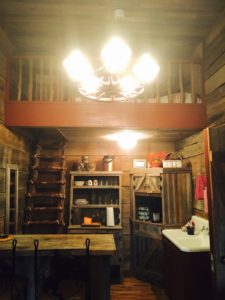
The “City Slicker Room,” also affectionately referred to as the “Bunkhouse,” is well-liked as well as the least expensive. With games lined up to play and even a saddle as an ottoman, this rustic, cozy space feels as if you have been invited into someone’s living room.
The suites are all very comfortable and welcoming. Larger parties can be accommodated by opening doors between the rooms making it an ideal location for bridal parties.
Tall ceilings and restored hardwood floors, as well as many original architectural elements such as glass door knobs, push- button light switches, and mail boxes add touches of character.
Scott and Sandy Kostelecky are the enthusiastic new owners of the Bed and Breakfast. They enjoy going the extra mile for their customers. Scott is even learning to perfect a heart made out of Hershey kisses for the bed in the “Honeymoon Suite”!
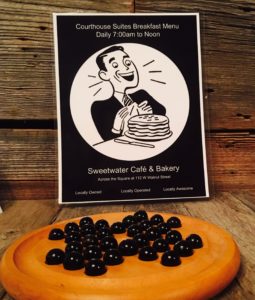 Amenities include en-suite bathrooms, kitchenettes, a balcony off the back of the building, and lofts in two of the rooms. There is even a half bath in the hallway in case someone in your room is taking too long! The Kosteleckys have recently partnered with Sweetwater Bakery to offer breakfast for their patrons.
Amenities include en-suite bathrooms, kitchenettes, a balcony off the back of the building, and lofts in two of the rooms. There is even a half bath in the hallway in case someone in your room is taking too long! The Kosteleckys have recently partnered with Sweetwater Bakery to offer breakfast for their patrons.
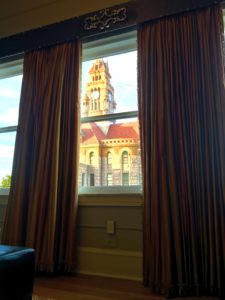
Combining history, comfort and good old- fashioned service make the Courthouse Bed and Breakfast the perfect stop in Decatur.
103A West Main Street
Look for the orange door.
www.courthousesuites.com
940-627-7005
LIONS AND TIGERS… AND LEMURS?… OH MY
Situated on a quiet 27 acres in Bridgeport, The Center for Animal Research and Education is an animal lover’s paradise. It is a sanctuary, which by very definition is a place of refuge and safety. Large, well-kept enclosures resembling giant playscapes dot the property. Made secure by the plentiful pipe from the Bridgeport oil fields, they are filled with toys, platforms, caves and even Christmas trees. It feels like a home. C.A.R.E, as it is more commonly known, is a non-profit organization born in 2003 out of a need to rescue, rehabilitate and provide long-term care to mainly large cats including tigers, lions, leopards and cougars. The Center is run by Heidi Krahn, a passionate lover of big cats. She lives on the property and rarely leaves. Saving these animals is her calling, her life’s work. For twelve years C.A.R.E. was a 100% volunteer organization. The facility now has one paid employee, Rachel as well as four interns who come from all over the world.


Visitors are first met by Dahlia, a three-legged Guanaco. She resembles a llama but is quite rare. She was a couple of weeks old and only twenty pounds when she was brought to C.A.R.E. with a broken leg. The leg eventually had to be amputated, but Dahlia has adapted wonderfully. She has surprising balance and can run as well as her four-legged counterparts. Dahlia did need a friend, however. Yolo is a shy llama, not very social with people, but she loves Dahlia, and she loves her. Theirs is a friendship born out of a need for companionship. Charlie Doubrava, a Decatur teen, built their enclosure as his Eagle Scout project, proof that the community generously supports this organization.
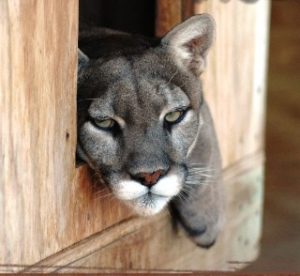
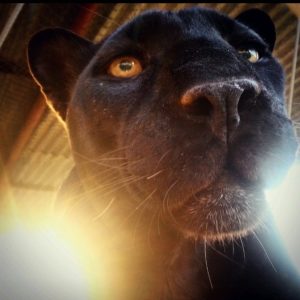
Moving along to the soft sounds of chuffing and the occasional roar, we come to the home of the geriatric leopards. Twenty -year- old Raven, a beautiful, black leopard with piercing yellow eyes and Tawny, a gorgeous seventeen- year- old cougar are spoiled rotten in their heated pens piled high with comfortable bedding. They are thrilled to be in out of the cold. You can tell by their purrs! C.A.R.E. is very fortunate to have these elderly cats whose lifespan in the wild is only about 10-12 years. Newer statistics suggest a tiger only has an average wild lifespan on 8 years. Their cats have lived upward of 20 years!

Once outside, we meet Cassie, the cougar. She has a wonderful habitat, complete with a rope bridge, ramps, and platforms she scales up and down with ease. Cassie loves to play ball. You will often see Cassie carrying her ball in her forearms walking on her back feet. She then carries the ball up the ramps or slam-dunks it in her hoop.If she feels jealous because others are getting attention she immediately starts talking and starts exhibiting her gymnastic abilities. In the last few years, Cassie has become quite the internet sensation with her adorable squeaks for attention!
Nearby are bobcats, Max and Mia. Because they were both so young when rescued, they have been placed together and are so happy to have each other. While the two used to look nothing alike, they can now almost pass as siblings.

Max’s story is unfortunately a common one for young bobcats. His mother was shot and a game warden found him orphaned. He took him in, and then relocated him to a wildlife refuge. The refuge asked us if we could give him a permanent home. By this time he was too habituated to people to be rehabbed and released. Bobcats are incredibly adaptable and live in a variety of environments. The bobcat is vital to controlling pest populations – and eats anything from small rodents to deer.


The lions are majestic. Mwali and Noel live in an enclosure at the front of the property. Heidi says Mwali is the most magnificent lion she has ever seen. He has been very sick recently, and the mysterious illness has taken its toll. He is under -weight and his once beautiful mane is thinning and matted. Heidi feared they might lose him, but under her watchful eye and due to the excellent care he is receiving, he is returning to his former glory.

Tigers, both orange and white, seem to come from all directions, each anxious for Heidi’s attention. She has a fascinating bond with her big cats. She speaks their language and loves on them all while maintaining a relationship “through the fence.” While it is obvious they all adore her, they are still large, strong and unpredictable. To get any closer would just be crazy. JP, a needy orange tiger, follows Heidi as she introduces us to more big cats and tells a story about when an errant duck found itself in Flash’s enclosure and terrified the giant white tiger.

At first glance, the lemur enclosure appears empty. Since these primates originate from Madagascar, they cannot handle cold temperatures. Although the day is very brisk, Heidi lures the cuties out with the promise of blueberries. The slight creatures are exceptionally entertaining albeit high maintenance. They only eat fruits and vegetables which have to be cut up for them. Their enclosures require temperature control and must be cleaned twice daily. Our brief encounter is fascinating. It is disconcerting to see such human-like mannerisms exhibited. While the lemurs did not stay out for long, their uniqueness left us wanting more.
Local farmers and owners bring either dead or dying cows, horses and chickens to the property. They are killed humanely if need be and then stored in a large freezer on the property as food for the cats. No healthy animals are accepted-big cats would not eat healthy specimens in the wild. It has a very “Circle of Life” feel to it.

A cemetery on the property commemorates the deceased with plaques. The area feels very reverent and leaves you knowing that these animals have been well loved. When an animal passes away, Heidi orders a complete pathology to help in continuing to provide utmost care.

Heidi is passionate about her charges’ health and future. C.A.R.E. provides an excellent, controlled environment for study and minimally invasive research. She partners with the National Institute of Health to study disease and longevity. Of particular interest is the fact that white tigers are very prone to Melanoma due to having both extremes of melanin. C.A.R.E. has lost several white tigers to this type of cancer. Together with the N.I.H., the Center is working to isolate the gene.
Heidi is very smart and very willing to discuss tough, ethical issues facing the likely will become extinct cats. Recent studies show there is not enough genetic diversity for tigers to survive more than 20-30 years. People want to argue ethics relating to these animals, but the reality is that there are not answers to many of the questions. The arguments could go on for days, but that is not Heidi’s focus. She intends to provide love and long-term care to those that have been entrusted to her. She worries about immediate needs such as water. Especially during times of drought, water is a vital concern. Each enclosure has a pool for the big cats to cool off in during the warm months. It takes all day to fill them because current wells are shallow; it is too expensive to drill deeper wells. She also worries how all her charges will handle the upcoming frigid temperatures, but realizes they will just have to get through it.
The organization participates in Wish List Wednesday through Amazon. Supporters are awesome and most wished for items are snapped up immediately. Still, ongoing needs are great. Adoptions are available for all the animals. The animals do not leave the C.A.R.E. facility; the money helps with each animal’s needs. Big cats can be adopted for $100 a month and lemurs for $50 a month. Sponsors are typically very involved with their animal. One individual has been sponsoring for 14 years, and even moved to be closer to her tiger. Another sponsor comes weekly to see the lions.
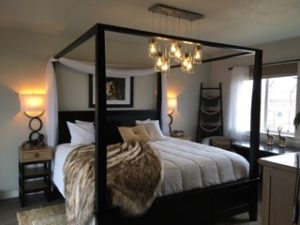 Always thinking of new ways to obtain funds, on September 2nd Heidi opened two luxury suites that overlook both the tiger and lion enclosures. The $1,000 per night suites offer an adult only, 24-hour big cat immersion paired with meals, massages, and opportunities to feed the animals.
Always thinking of new ways to obtain funds, on September 2nd Heidi opened two luxury suites that overlook both the tiger and lion enclosures. The $1,000 per night suites offer an adult only, 24-hour big cat immersion paired with meals, massages, and opportunities to feed the animals.
The need is always there. Just weeks ago C.A.R.E. became the new home for four juvenile tigers being from Florida. Two girls, Shaanti and Naya and two boys, Nadal and Divali, are the new stars of the show. Their feet had never touched grass; they had never seen the sky. To say the babies are enjoying their new home would be an understatement! To stand at the fence and watch them is pure joy! You can not only see and hear their happiness; you can feel it. Heidi is ecstatic to welcome a new generation to C.A.R.E.

C.A.R.E. is a place to come for perspective. You leave self-centeredness at the front gate. You can ponder what is happening to the earth…how our choices will impact the planet going forward. Visiting this sanctuary is a magical experience that allows the mind to wander. No matter what is going on in your life, you can find peace among these beautiful, loving creatures. You feel grateful for Heidi and her determination to provide a haven for these endangered animals.
For tour and donation information please visit:http://carerescuetexas.com/
“Saving one animal won’t change the world, but it will change the world for that one animal” Vicki Davis
Greenwood Artist, Rick Duwe, Completes Mural
Every morning as he started work on the “Greetings from Decatur” mural on the east side of the square, Greenwood artist Rick Duwe took time for prayer.
“I’d lay my hand on that wall and say, ‘God, paint this mural through my hands,’” Duwe said, adding: “‘and let everybody like it, especially Mark Moran.’”
Moran, a local real estate developer, commissioned the mural as part of a larger effort to beautify downtown using local talent. The mural is on a wall next to a 12-foot tall steel sculpture of two suspended dice by Bridgeport designers Jake and Daniel Hayhurst and Kris Hibbitts on property shared by a recently resurfaced parking lot.
For Duwe, a longtime Wise County resident, the mural is a way to preserve the historical identity of a quickly-growing community.
“I think it’s inevitable the Metroplex is coming our way,” he said. “To have something creative for the town is fun for the town and people. It’s interesting and good.”
Duwe said the mural is based on a similar painting in Austin, which is styled after a series of postcards from the 1930s.
“Mark told me he wanted it like the one they have in Austin,” he said. “I said, ‘Well I haven’t seen that.’ So I Googled it.”
The two scoped out the wall for the prospective mural, deciding on 12 by 27 feet. The dimensions were later increased to 14 by 32 to better fill the wall.
After the initial planning session, Duwe drew several sketches of the mural, eventually graduating to a painted prototype.
“This painting was geared toward 12 by 27 [feet],” he said. “So when it went bigger, I had to redraw the whole thing to make it fit.”
Duwe then projected a transparent outline of his mural onto the wall to trace. From there, he said the process of shading the mural was simple. Duwe’s son, Dave, assisted in filling in the lines.
“It was sort of like a coloring book,” he said. “Austin’s mural is very simple. Mark told me he wasn’t looking for detail.”
Also like the Austin art, a local landmark is portrayed in each of the letters of the town’s name. Decatur’s seven letters include depictions of the Waggoner Mansion, a scene from the Chisholm Trail cattle drive, the Woody cabin, the Wise County courthouse, the petrified wood gas station and the Wise County Heritage Museum, which formerly housed the Decatur Baptist College. Duwe said he and Moran brainstormed a list of recognizable landmarks to include in the mural.
“We’ve lived in Greenwood for 31 years, so I kind of had an idea of what was iconic for the town,” Duwe said.
“The ‘R’ has, as Austin’s has, a Texas flag on the last letter,” he said. “It was just something to fill in that space. We couldn’t think of another strong landmark that’s easy to recognize.”
Recently, Duwe said he’s focused more on painting nature and landscapes, but he’s also painted murals for Slidell and Chico school districts.
“I’m more of a realistic-type painter,” he said. “And it’s hard for me to do something in a graphic-illustrated way. When it comes to the mural, I thought I wanted to put down the values – the darks and the lights. So that’s what makes things look real is you have the proper shades of color in the shadows and in the sunlight. I told Mark, I said, ‘I want it to be not just good, but special.’”
Before he started painting, Duwe said he worked with Moran to add a cement and fiberglass layer over the wall’s original brickwork to make a better canvas for the mural.
After the painting was finished, he said he added white paint to several areas to offset the mural’s more aggressive colors.
“I did put some washes on that blue. I might have covered it twice,” he said. “That faded it out some. I faded the reds, maybe even the dice, too because it subdued them.”
The end result took around three gallons of paint and about four weeks to complete. Like the prayer he said before each day’s work, the finished product is straightforward and effective.
“It was the idea to keep it simple,” he said. “You’ve got a lot of background color, and as long as you can keep your lines fairly straight around your letters, it’s simple to do. God gave me a lot of good weather to do that.”
Postcard from home; Mural preserves city’s historical identity
Southern Hospitality – Memory Lane Mercantile
Much has been said about small town, Southern hospitality. In Decatur, Texas it is real and embodied in Memory Lane Mercantile proprietor, Jennifer Smurthwaite. Jennifer sees hospitality as her gift and gifted she is.
Upon entering her store, patrons immediately feel welcomed and appreciated. She has a warm and easy way with people. It is extraordinary in this day and time to have someone go out of their way to make a shopping experience unique. She encourages shoppers to slow down and take their time in the store often offering coffee and suggestions for other places of interest. She forms relationships and gets to know customers…even at times giving out her cell phone number.
Generous and supportive to the town that helped raise her children, Jennifer exudes a love for Decatur. By featuring local artisans and providing a meeting place for various activities, she is helping to build a better community.
Beautiful window designs and fabulous collections to shop from are enticing, but Jennifer is the true find in Memory Lance Mercantile.
You may walk in Memory Lane Mercantile a stranger, but you will leave a friend. Now that’s hospitality!!
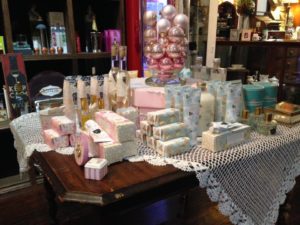
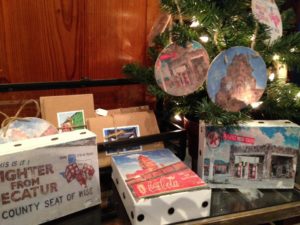

Who in the World is J. Riely Gordon?
Are you familiar with J. Riely Gordon? Chances are, if you have not heard the name you are a least very familiar with his work. Riely, a nationally recognized architect from San Antonio, Texas, was most known for his 18 beautiful Texas courthouses erected between 1883 and 1898. You guessed it! He was the architect that designed our very own Wise County Courthouse. Built between 1895 and 1896 our courthouse was deemed architecturally perfect by the design community. The Texas pink granite beauty became the crown jewel of the Decatur Town Square. We are in good company as the Texas State Capitol is also made out of pink granite. Why pink granite? The stone is beautiful and unique, but it may have had more to do with the fact that Texas is home to the second largest granite deposit in the world.
The Decatur Town Square, which was laid out in 1857, was now ready to take its place in Texas history.
We want to pay tribute to Decatur Town Square’s history as well as applaud its revitalization
Great things have happened ~ Great things are coming
People in small towns, much more than cities, share a destiny ~ Richard Russo


